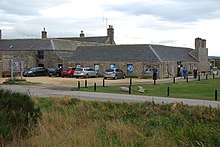Tugnet Salmon Fishing Station
The Tugnet Salmon Fishing Station is a former fishing operation in the Scottish village of Spey Bay in the Moray Council Area , which is now the Scottish Dolphin Center . In 1971 the building was included in the Scottish monument lists, initially in category B. The upgrade to the highest monument category A took place in 1988. The associated ice house is classified separately as a category A monument. Together the complexes form a monument ensemble.
history
The lands were owned by the Dukes of Gordon in the 18th century . For economic development, Alexander Gordon, 4th Duke of Gordon had the fishing company built there from the 1770s. The first complex, built in 1772, was probably designed by the Scottish architect John Baxter . 1783 additional buildings added. The fish were initially transported by ship. In 1792, 24 shiploads of salmon were loaded for sale in London . At this time 150 people were employed on the plant.
An ice house was located on site for the cooled storage of the catch . As its dimensions were soon no longer sufficient, a new ice house complex was built in 1830. The ice required was produced in specially designed pools between the ice house and the coast. The ice house was filled with the icefall through the upper doors. The ice house was last used in 1968. Finally, the fish was no longer transported by ship, but by train.
The Moray district had the complex restored and set up a museum center there on the subject of salmon fishing, wildlife and boat building. Today the facility is home to the Scottish Dolphin Center .
description
The Tugnet Salmon Fishing Station is on the western edge of the hamlet of Spey Bay at the mouth of the Speys and the Moray Firth . The masonry of the two-storey building complex consists of rubble stone roughly cut into cuboids, which was built into layered masonry. Two connected groups of buildings each enclose an inner courtyard. A segment arched doorway leads to the inner courtyard. Twelve-part lattice windows are embedded along the facade . The masonry of the U-shaped continuation is made of quarry stone. The roofs are covered with slate from Banffshire .
Ice house
The ice house is considered one of the most important in Scotland in terms of architecture and history. It is also considered the largest ice house in Scotland. It consists of three elongated buildings with grass-covered barrel roofs . The interior of the building is divided. The buildings are connected to each other.
Individual evidence
- ↑ a b c d Listed Building - Entry . In: Historic Scotland .
- ↑ a b Listed Building - Entry . In: Historic Scotland .
- ↑ a b c Entry on Tugnet Salmon Fishing Station in Canmore, the database of Historic Environment Scotland (English)
- ^ Entry in the Gazetteer for Scotland
- ↑ Information about the Scottish Dolphin Centers
Web links
- Network presence of the Scottish Dolphin Center
- Entry on Tugnet Salmon Fishing Station in Canmore, Historic Environment Scotland's database
Coordinates: 57 ° 40 ′ 24.3 " N , 3 ° 5 ′ 33.1" W.

